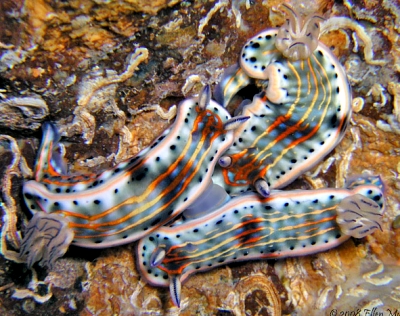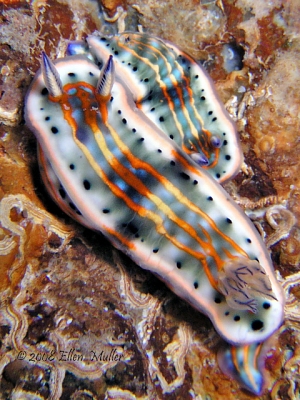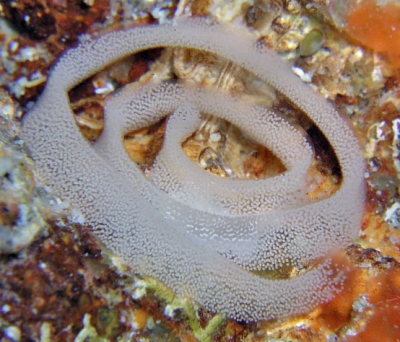Re: Hypselodoris bayeri ? from Bonaire
July 18, 2008
From: Ellen Muller

Hi Bill,
Here are some photos of hypselodorids, named 'Hypselodoris sp. 3.' in the book "Caribbean Sea Slugs " (Valdes, Hamann, Behrens, DuPont), They were found under the Town Pier in Bonaire [Lesser Antilles, Caribbean] at a depth of 20 ft. and ranged in size from 1/2 inch to 1 1/2 inches. Linda Baker found the first one on May 10th 2008, 9:30pm on a discarded grape stem. I went back 2 nights later and found two of them on a discarded plastic fork that had some encrusting sponges growing on it. May 14th, 2008, 10 pm. I found 4 individuals. A pair was mating and I also found 2 egg coils. May 18th, 2008 I found a few more individuals and also saw a pair mating. I have included some photos of them mating and one of the egg coils.
Best regards,
Ellen Muller
ellen@imaginebonaire.com



Dear Ellen,
Thanks for this valuable observation. This animal belongs to a somewhat confusing group of species which are still not sorted out. I think the most likely situation is that some of these 'species' were described from single specimens, which in fact represented colour variations of just one species with a very variable colour pattern. The most obvious difference is that in some animals there are yellow-brown and blue longitudinal lines while in others the blue can be reduced to a scattering of spots and the rest of the background becomes yellow-brown. Phillip Gillette's photos [message #13022 ] give a good example showing the blue lines breaking up into spots.
I may be quite wrong, as another feature of chromodorids is that species sometimes mimic other species in appearance, so it is possible we are looking at a case of mimicry. If they are different species, then hopefully some of these colour differences can be linked to anatomical differences, but sometimes anatomical differences are too subtle to be useful. Your inclusion of an egg ribbon however is very valuable, because often egg masses can give us a clue. Hopefully, in time, other egg ribbons, which can be identified to particular colour forms will be found. I also note in Caribbean Sea Slugs that this colour form is reported to feed on a blue sponge of the genus Dysidea. If you have any photos showing the sponge you found these animals on, it could be an interesting addition. Species of Dysidea are the usual food of species of Hypselodoris but there is always a possibility that one of the 'colour forms' of this blue-lined/blue-spotted group eats a different type of sponge.
Best wishes,
Bill Rudman
Related messages
-
Re: Hypselodoris bayeri in Curacao
From: Terence Zahner, January 18, 2010 -
Hypselodoris bayeri in Curacao
From: Terence Zahner, January 14, 2010 -
Re: Hypselodoris acriba or H. bayeri?
From: Wayne Atkinson, August 31, 2009 -
A new chromodorid from the Caribbean?
From: Lureen Ferretti, August 27, 2009 -
Hypselodoris bayeri from Bonaire
From: Pam McPherson, September 5, 2008 -
Chromodorid from Bonaire
From: Per Lagerberg, October 17, 2007 -
Hypselodoris bayeri from Honduras
From: Florent Charpin, June 27, 2006 -
Hypselodoris acriba or H. bayeri?
From: Valda Bromfield, June 19, 2006 -
Hypselodoris sp. 5 from Honduras
From: Les Wilk, December 14, 2005 -
Colour variant of Hypselodoris sp. 5 from St Kitts
From: Kelly Griggs, February 4, 2005 -
Hypselodoris bayeri from Florida
From: Phillip Gillette, February 3, 2005 -
Re: Hypselodoris from Bonaire (Caribbean)
From: Ron Velarde, May 27, 2003 -
Hypselodoris bayeri? from Colombia
From: Néstor E. Ardila , February 23, 2003 -
Radula of Hypselodoris bayeri?
From: Néstor E. Ardila , February 23, 2003 -
Hypselodoris bayeri from Belize
From: Dave Behrens, September 27, 2002 -
Hypselodoris bayeri - Marcus photo
From: Bill Rudman, September 23, 2002
